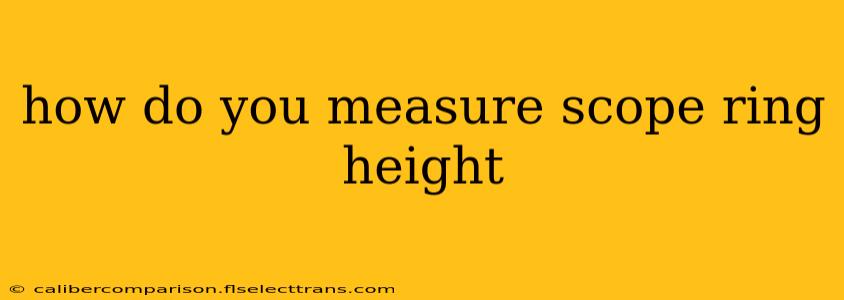Choosing the right scope rings is crucial for proper rifle scope mounting and optimal shooting performance. One of the most critical aspects is determining the correct scope ring height. Getting this wrong can lead to clearance issues, an uncomfortable cheek weld, and even damage to your scope or rifle. This guide provides a step-by-step process for accurately measuring scope ring height.
Understanding Scope Ring Height
Scope ring height refers to the distance between the top of your rifle's receiver and the center of your scope's tube. It's measured in inches or millimeters. Choosing the wrong height can result in:
- Insufficient clearance: The scope might hit the ejection port or other parts of the rifle during operation.
- Poor cheek weld: An improper scope height can force you into an awkward and uncomfortable shooting position.
- Scope damage: A low-mounted scope is vulnerable to damage from recoil.
Methods for Measuring Scope Ring Height
There are two primary methods for determining the correct scope ring height:
Method 1: Direct Measurement (Most Accurate)
This method offers the most precise measurement and is recommended whenever possible.
1. Gather Your Equipment:
- Your rifle: Ensure it's unloaded and safe.
- Your scope: This allows for the most accurate measurement.
- Caliper or ruler: A digital caliper provides the most accurate reading. A ruler will suffice if using a less precise method.
- Pen or pencil: For marking.
2. Prepare Your Rifle and Scope:
- Position the scope: Carefully place your scope onto the rifle receiver as if it were mounted. Don't actually mount it yet.
3. Measure the Height:
- Find the reference points: Identify the highest point on the receiver where the scope rings will sit. This is often the top of the receiver itself but could vary based on the design. Similarly, find the center of the scope's main tube.
- Measure the distance: Use your caliper or ruler to measure the distance between these two points. This measurement represents the minimum height required for your scope rings. Add a small margin of error (around 1/16th of an inch or 1-2mm) to ensure proper clearance.
4. Determine Ring Height:
- Consult ring specifications: Once you've got the measurement, refer to the specifications of the scope rings you're considering. They will list their height. Choose rings with a height equal to or slightly greater than your measurement.
Method 2: Using Existing Scope Ring Height (Estimate)
If you're replacing your rings or need a quick estimate, you can use your existing rings as a reference point.
1. Measure the Existing Rings:
- Remove the scope and rings: Carefully remove your existing scope and rings.
- Measure the ring height: Measure the height of your existing rings using a caliper or ruler. This will give you a starting point for selecting replacement rings.
2. Account for Changes:
- Scope size: If you're changing to a scope with a different diameter, you'll need to adjust your measurement accordingly. Larger diameter scopes will generally require taller rings.
- Base type: The type of base used (Weaver, Picatinny, etc.) can also influence the required ring height.
Selecting Your Scope Rings
Once you have your measurement, selecting appropriate rings is straightforward. Always ensure the ring size is compatible with your scope's diameter and your rifle's base. Remember, it's better to choose slightly taller rings than risk insufficient clearance.
Conclusion
Accurate scope ring height measurement is critical for proper scope mounting and safe shooting. By following the methods described above, you can ensure your scope is mounted correctly, providing a safe, comfortable, and accurate shooting experience. Remember to always prioritize safety and handle firearms responsibly.

